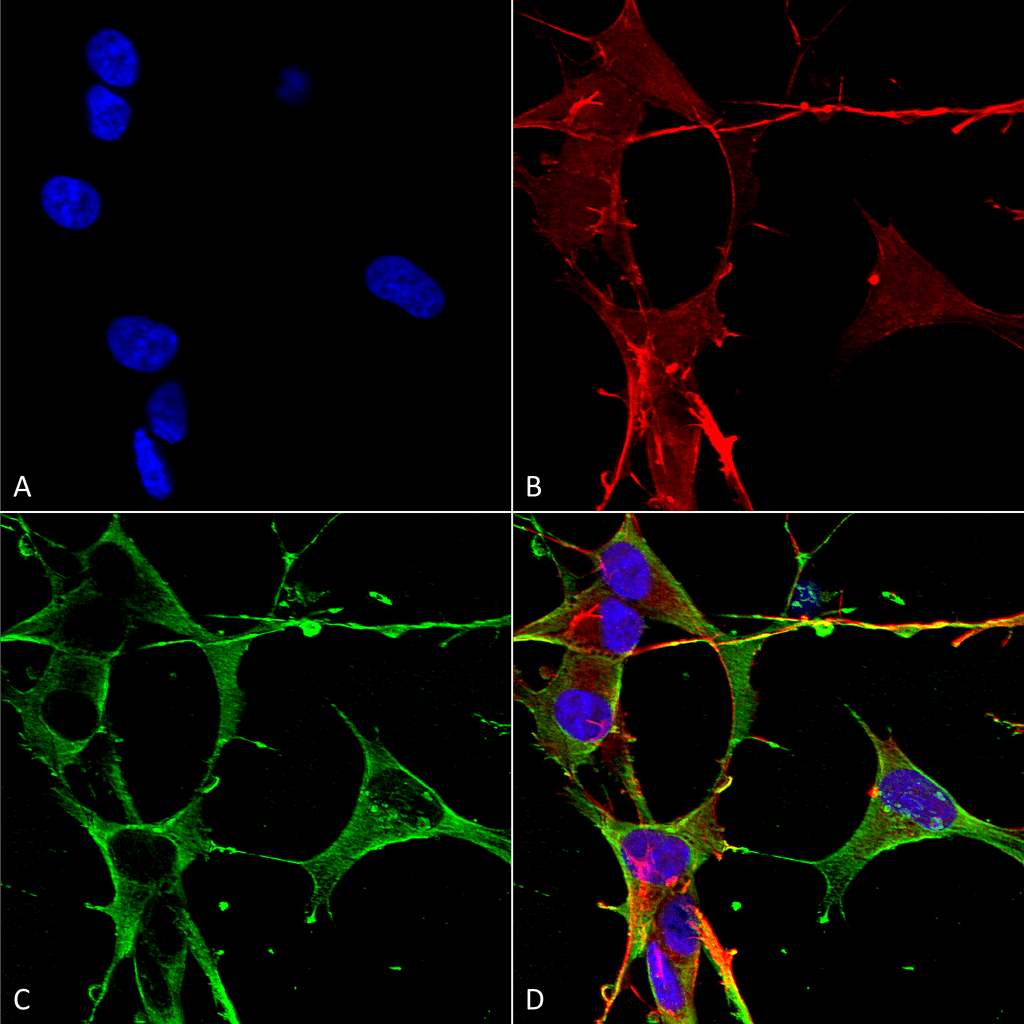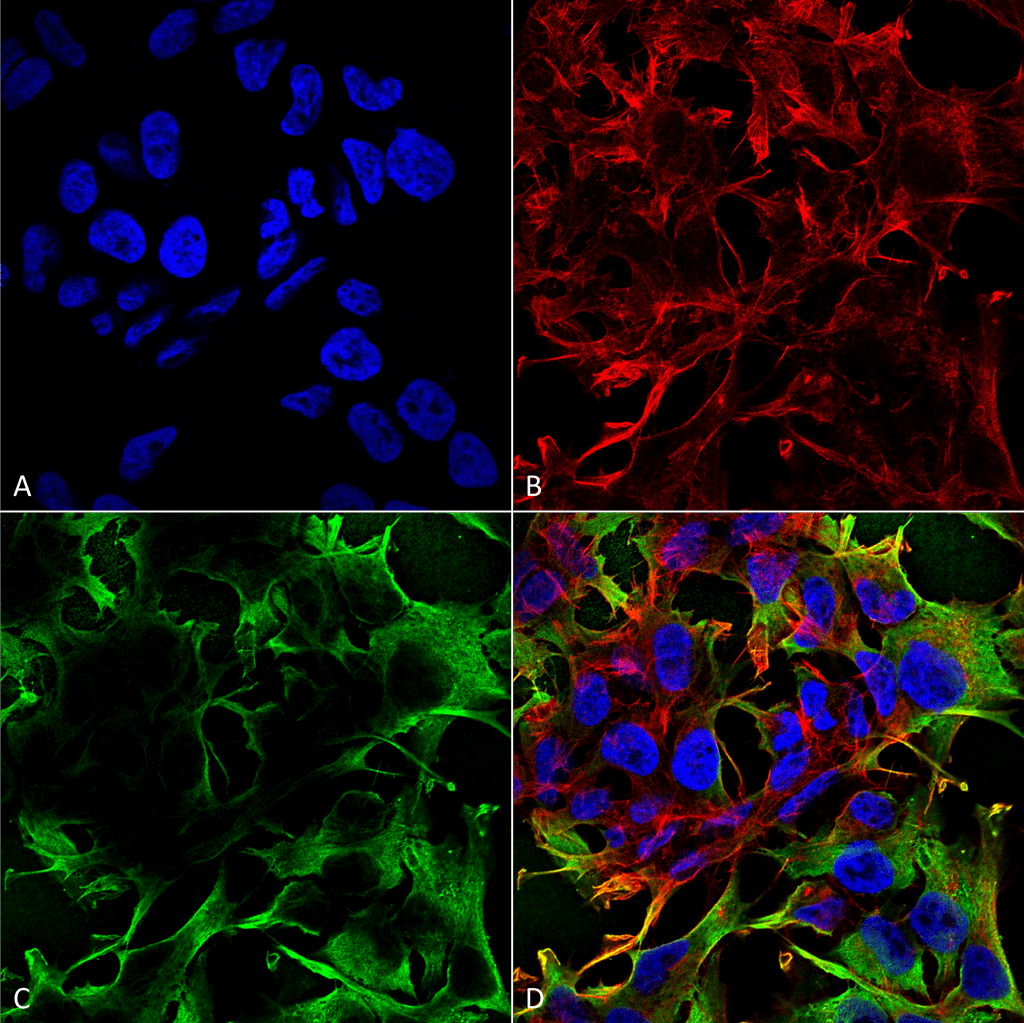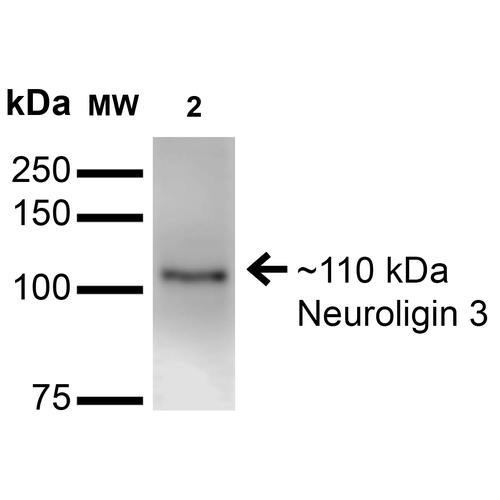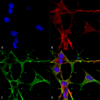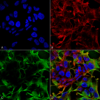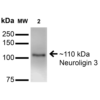Anti-Neuroligin-3 Antibody (56552)
$466.00
| Host | Quantity | Applications | Species Reactivity | Data Sheet | |
|---|---|---|---|---|---|
| Mouse | 100ug | WB,IHC,ICC/IF | Human, Mouse, Rat |  |
SKU: 56552
Categories: Antibody Products, Neuroscience and Signal Transduction Antibodies, Products
Overview
Product Name Anti-Neuroligin-3 Antibody (56552)
Description Anti-Neuroligin-3 Mouse Monoclonal Antibody
Target Neuroligin-3
Species Reactivity Human, Mouse, Rat
Applications WB,IHC,ICC/IF
Host Mouse
Clonality Monoclonal
Clone ID S110-29
Isotype IgG1
Immunogen Fusion protein corresponding to aa 730-848 (intracellular C-terminus) of rat Neuroligin- 3. This sequence is 99
Properties
Form Liquid
Concentration 1.0 mg/mL
Formulation PBS, pH 7.4, 0.1% sodium azide, 50% glycerol.
Buffer Formulation Phosphate Buffered Saline
Buffer pH pH 7.4
Buffer Anti-Microbial 0.1% Sodium Azide
Buffer Cryopreservative 50% Glycerol
Format Purified
Purification Purified by Protein G affinity chromatography
Specificity Information
Specificity This antibody recognizes human, mouse and rat Neuroligin-3. It does not cross- react with Neuroligin-1, -2, or -4.
Target Name Neuroligin-3
Target ID Neuroligin-3
Uniprot ID Q62889
Alternative Names Gliotactin homolog
Gene Name Nlgn3
Sequence Location Cell membrane; Single-pass type I membrane protein. Cell junction, synapse. Note=Detected at both glutamatergic and GABAergic synapses.
Biological Function Cell surface protein involved in cell-cell-interactions via its interactions with neurexin family members. Plays a role in synapse function and synaptic signal transmission, and probably mediates its effects by recruiting and clustering other synaptic proteins. May promote the initial formation of synapses, but is not essential for this. May also play a role in glia-glia or glia-neuron interactions in the developing peripheral nervous system. {PubMed:17897391}.
Research Areas Neuroscience
Background Neuroligin-3 is a neuronal cell surface protein involved in cell-cell-interactions via its interactions with neurexin family members. It plays a role in synapse function and synaptic signal transmission, and may mediate its effects by clustering other synaptic proteins. It may also promote the initial formation of synapses and play a role in glia-glia or glia-neuron interactions in the developing peripheral nervous system. Mutations in this gene may be associated with autism and Asperger syndrome. Multiple transcript variants encoding distinct isoforms have been identified for this gene.
Application Images




Description Immunocytochemistry/Immunofluorescence analysis using Mouse Anti-Neuroligin 3 Monoclonal Antibody, Clone S110-29 (56552). Tissue: Neuroblastoma cells (SH-SY5Y). Species: Human. Fixation: 4% PFA for 15 min. Primary Antibody: Mouse Anti-Neuroligin 3 Monoclonal Antibody (56552) at 1:50 for overnight at 4°C with slow rocking. Secondary Antibody: AlexaFluor 488 at 1:1000 for 1 hour at RT. Counterstain: Phalloidin-iFluor 647 (red) F-Actin stain; Hoechst (blue) nuclear stain at 1:800, 1.6mM for 20 min at RT. (A) Hoechst (blue) nuclear stain. (B) Phalloidin-iFluor 647 (red) F-Actin stain. (C) Neuroligin 3 Antibody (D) Composite.

Description Immunocytochemistry/Immunofluorescence analysis using Mouse Anti-Neuroligin 3 Monoclonal Antibody, Clone S110-29 (56552). Tissue: Neuroblastoma cell line (SK-N-BE). Species: Human. Fixation: 4% Formaldehyde for 15 min at RT. Primary Antibody: Mouse Anti-Neuroligin 3 Monoclonal Antibody (56552) at 1:100 for 60 min at RT. Secondary Antibody: Goat Anti-Mouse ATTO 488 at 1:100 for 60 min at RT. Counterstain: Phalloidin Texas Red F-Actin stain; DAPI (blue) nuclear stain at 1:1000, 1:5000 for 60min RT, 5min RT. Localization: Cell Membrane, Cell Junction, Synapse . Magnification: 60X. (A) DAPI (blue) nuclear stain. (B) Phalloidin Texas Red F-Actin stain. (C) Neuroligin 3 Antibody. (D) Composite.

Description Western Blot analysis of Mouse Brain Membrane showing detection of ~110 kDa Neuroligin 3 protein using Mouse Anti-Neuroligin 3 Monoclonal Antibody, Clone S110-29 (56552). Lane 1: Molecular Weight Ladder. Lane 2: Mouse Brain Membrane. Load: 15 µg. Block: 2% BSA and 2% Skim Milk in 1X TBST. Primary Antibody: Mouse Anti-Neuroligin 3 Monoclonal Antibody (56552) at 1:200 for 16 hours at 4°C. Secondary Antibody: Goat Anti-Mouse IgG: HRP at 1:1000 for 1 hour RT. Color Development: ECL solution for 6 min in RT. Predicted/Observed Size: ~110 kDa.
Handling
Storage This product is stable for at least one (1) year at -20°C.
Dilution Instructions Dilute in PBS or medium that is identical to that used in the assay system.
Application Instructions Immunoblotting: use at 1-5ug/mL. A band of ~110kDa is detected.
Immunofluorescence: use at 10ug/mL.
These are recommended concentrations.
Endusers should determine optimal concentrations for their application.
Immunofluorescence: use at 10ug/mL.
These are recommended concentrations.
Endusers should determine optimal concentrations for their application.
References & Data Sheet
Data Sheet  Download PDF Data Sheet
Download PDF Data Sheet
 Download PDF Data Sheet
Download PDF Data Sheet

